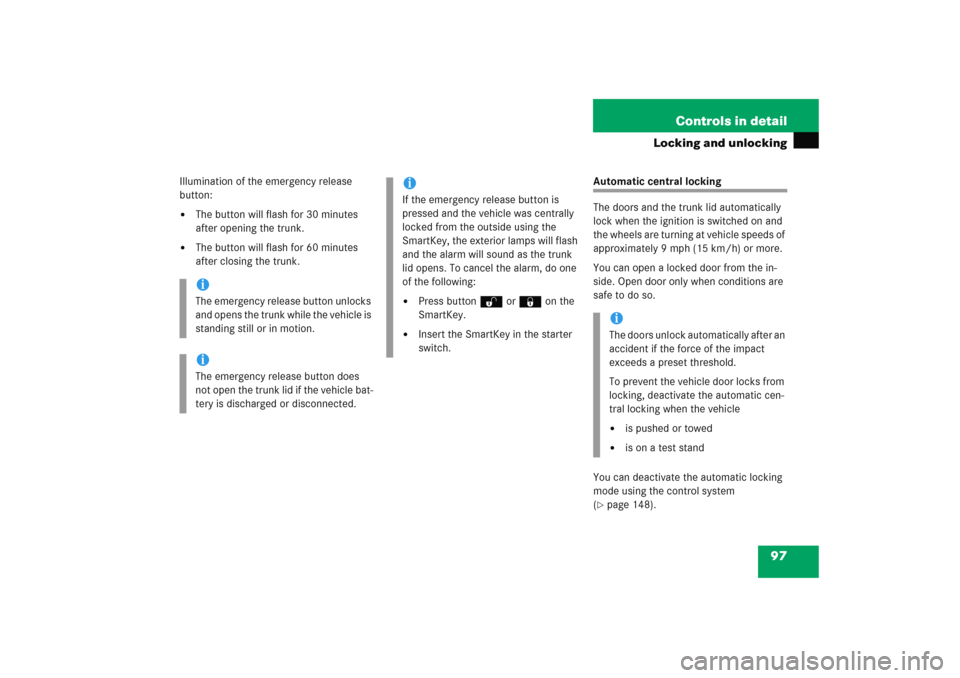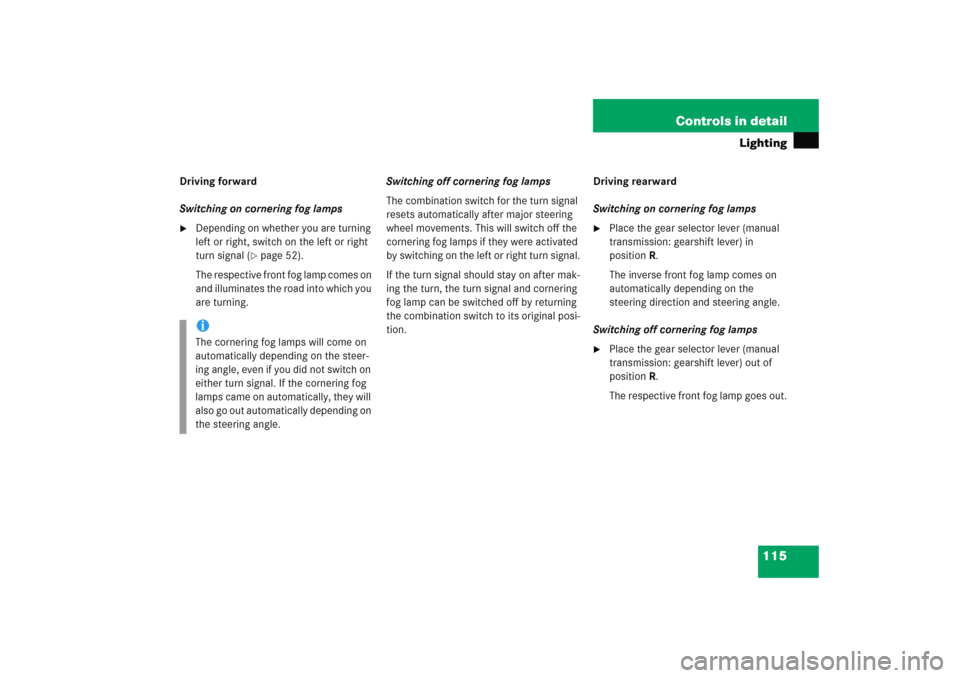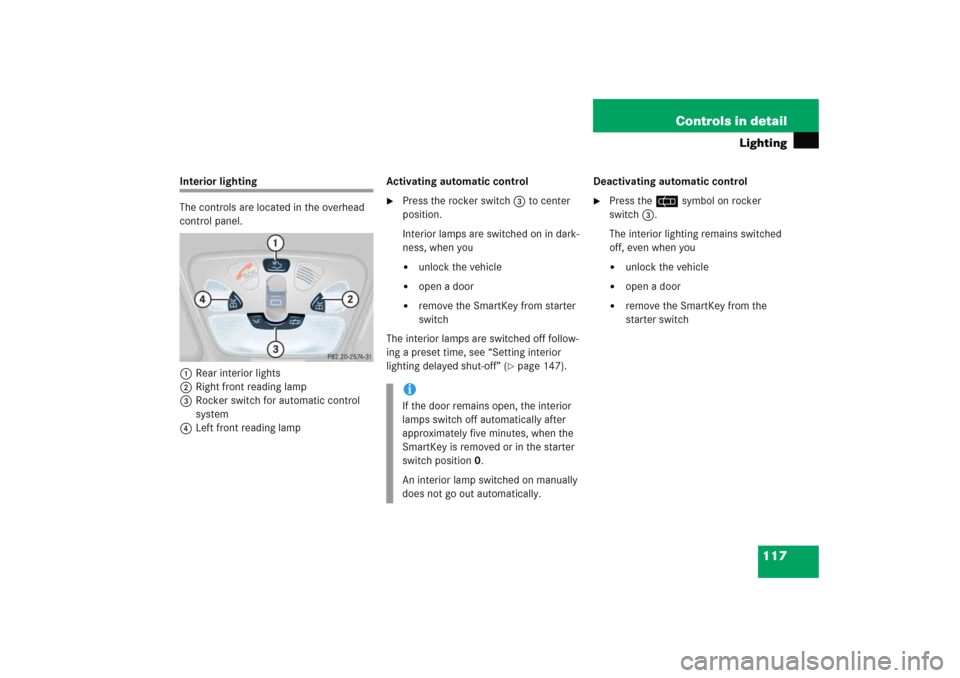Page 75 of 474

74 Safety and SecurityOccupant safetyWhen the OCS senses that the front passen-
ger seat occupant is classified as being
heavier than the weight of a typical
12-month-old child seated in a standard
child restraint or as being a small individual
(such as a young teenager or a small adult),
the 56 indicator lamp will illuminate
for approximately six seconds when the en-
gine is started and then, depending on occu-
pant weight sensor readings from the seat,
remain illuminated or go out. With the
56 indicator lamp illuminated, the
front passenger front air bag is deactivated.
With the 56indicator lamp out, the
front passenger front air bag is activated.
When the OCS senses that the front passen-
ger seat occupant is classified as an adult or
someone larger than a small individual, the
56 indicator lamp will illuminate for
approximately six seconds when the engine
is started and then go out, indicating that
the front passenger front air bag is activat-
ed.
If the 56indicator lamp is
illuminated, the front passenger front air
bag is deactivated and will not be deployed.
If the 56indicator lamp is not illumi-
nated, the front passenger front air bag is
activated and will be deployed:�
in the event of certain frontal impacts
�
if impact exceeds a preset deployment
threshold
�
independently of the side impact air
bags.
If the front passenger front air bag is
deployed, the rate of inflation will be
influenced by:
�
the rate of relevant vehicle deceleration
as assessed by the air bag control unit
�
front passenger's weight category as
identified by the Occupant Classification
System (OCS).
Warning!
G
According to accident statistics, children
are safer when properly restrained in the
rear seating positions than in the front seat-
ing position. Thus, we strongly recommend
that children be placed in the rear seats
whenever possible. Regardless of seating
position, children 12 years old and under
must be seated and properly secured in an
appropriate infant or child restraint recom-
mended for the size and weight of the child.
The infant or child restraint must be properly
secured with the vehicle’s seat belt, the seat
belt and top tether strap, or lower anchors
and top tether strap, fully in accordance
with the child seat manufacturer's instruc-
tions.
��
Page 98 of 474

97 Controls in detail
Locking and unlocking
Illumination of the emergency release
button:�
The button will flash for 30 minutes
after opening the trunk.
�
The button will flash for 60 minutes
after closing the trunk.
Automatic central locking
The doors and the trunk lid automatically
lock when the ignition is switched on and
the wheels are turning at vehicle speeds of
approximately 9 mph (15 km/h) or more.
You can open a locked door from the in-
side. Open door only when conditions are
safe to do so.
You can deactivate the automatic locking
mode using the control system
(�page 148).
iThe emergency release button unlocks
and opens the trunk while the vehicle is
standing still or in motion.iThe emergency release button does
not open the trunk lid if the vehicle bat-
tery is discharged or disconnected.
iIf the emergency release button is
pressed and the vehicle was centrally
locked from the outside using the
SmartKey, the exterior lamps will flash
and the alarm will sound as the trunk
lid opens. To cancel the alarm, do one
of the following:�
Press buttonŒ or‹ on the
SmartKey.
�
Insert the SmartKey in the starter
switch.
iThe doors unlock automatically after an
accident if the force of the impact
exceeds a preset threshold.
To prevent the vehicle door locks from
locking, deactivate the automatic cen-
tral locking when the vehicle�
is pushed or towed
�
is on a test stand
Page 116 of 474

115 Controls in detail
Lighting
Driving forward
Switching on cornering fog lamps�
Depending on whether you are turning
left or right, switch on the left or right
turn signal (
�page 52).
The respective front fog lamp comes on
and illuminates the road into which you
are turning.Switching off cornering fog lamps
The combination switch for the turn signal
resets automatically after major steering
wheel movements. This will switch off the
cornering fog lamps if they were activated
by switching on the left or right turn signal.
If the turn signal should stay on after mak-
ing the turn, the turn signal and cornering
fog lamp can be switched off by returning
the combination switch to its original posi-
tion.Driving rearward
Switching on cornering fog lamps
�
Place the gear selector lever (manual
transmission: gearshift lever) in
positionR.
The inverse front fog lamp comes on
automatically depending on the
steering direction and steering angle.
Switching off cornering fog lamps
�
Place the gear selector lever (manual
transmission: gearshift lever) out of
positionR.
The respective front fog lamp goes out.
iThe cornering fog lamps will come on
automatically depending on the steer-
ing angle, even if you did not switch on
either turn signal. If the cornering fog
lamps came on automatically, they will
also go out automatically depending on
the steering angle.
Page 118 of 474

117 Controls in detail
Lighting
Interior lighting
The controls are located in the overhead
control panel.
1Rear interior lights
2Right front reading lamp
3Rocker switch for automatic control
system
4Left front reading lampActivating automatic control
�
Press the rocker switch3 to center
position.
Interior lamps are switched on in dark-
ness, when you�
unlock the vehicle
�
open a door
�
remove the SmartKey from starter
switch
The interior lamps are switched off follow-
ing a preset time, see “Setting interior
lighting delayed shut-off” (
�page 147).Deactivating automatic control
�
Press the =symbol on rocker
switch3.
The interior lighting remains switched
off, even when you�
unlock the vehicle
�
open a door
�
remove the SmartKey from the
starter switch
iIf the door remains open, the interior
lamps switch off automatically after
approximately five minutes, when the
SmartKey is removed or in the starter
switch position0.
An interior lamp switched on manually
does not go out automatically.
Page 120 of 474

119 Controls in detail
Instrument cluster
�Instrument cluster
For a full view illustration of the instrument
cluster, see “At a glance” (
�page 24).
1Reset button
The instrument cluster is activated when
you
�
open a door
�
switch on the ignition (
�page 33)
�
press reset button1
�
switch on the exterior lamps
You can change the instrument cluster
settings in the instrument cluster submenu
of the control system (
�page 137).
Instrument cluster illumination
Use reset button1 to adjust the
illumination brightness for the instrument
cluster.To brighten illumination
�
Turn reset button1 clockwise.
The instrument cluster illumination will
brighten.
To dim illumination
�
Turn reset button1 counterclock-
wise.
The instrument cluster illumination will
dim.
iThe instrument cluster illumination is
dimmed or brightened automatically to
suit ambient light conditions.
The instrument cluster illumination will
also be adjusted automatically when
you switch on the vehicle’s exterior
lamps.
Page 122 of 474

121 Controls in detail
Instrument cluster
Trip odometer�
Make sure you are viewing the trip
odometer and main odometer in the
multifunction display (
�page 123).
�
If it is not displayed, press buttonè
orÿ on the multifunction steering
wheel until the trip odometer appears
(�page 124).
�
Press and hold the reset button in the
instrument cluster (
�page 119) until
the trip odometer is reset.
Tachometer
The red marking on the tachometer
(�page 24) denotes excessive engine
speed.
To help protect the engine, the fuel supply
is interrupted if the engine is operated
within the red marking.
Outside temperature indicator
!Avoid driving at excessive engine
speeds, as it may result in serious
engine damage that is not covered by
the Mercedes-Benz Limited Warranty.
Warning!
G
The outside temperature indicator is not de-
signed to serve as an ice-warning device and
is therefore unsuitable for that purpose.
Indicated temperatures just above the freez-
ing point do not guarantee that the road sur-
face is free of ice. The road may still be icy,
especially in wooded areas or on bridges.
Page 128 of 474
127 Controls in detail
Control system
Menus, submenus and functions
Menu1
Menu2
Menu3
Menu4
Menu5
Menu6
Menu7
Standard
display
AUDIO
NAV*
Vehicle status
message memory
Settings
Trip computer
Telephone*
(�page 128)
(�page 129)
(�page 131)
(�page 132)
(�page 133)
(�page 151)
(�page 153)
Commands/submenusDigital
speedometer or
outside tempera-
ture
Select radio sta-
tion
Activate route
guidance
Call up vehicle mal-
function, warning
and system status
messages stored
in memory
Reset to factory
settings
Fuel consump-
tion statistics af-
ter start
Load phone
book
Call up mainte-
nance service
display
Select satellite
radio station*
(USA only)
Instrument clus-
ter submenu
Fuel consump-
tion statistics
since the last
reset
Search for name
in phone book
Check engine oil
level
Operate the
CD player*
Time/Date
submenu
Call up range
Lighting
submenuVehicle
submenuConvenience
submenu
Page 131 of 474
130 Controls in detailControl systemSelect radio station�
Turn on the radio (
�page 198).
Vehicles with COMAND*:
Refer to separate operating
instructions.
�
Press buttonè orÿ repeatedly
until the currently tuned station
appears in the multifunction display.
1Waveband setting
2Station frequency
�
Press buttonk orj repeatedly
until the desired station is found.Select satellite radio station*
(USA only)
The satellite radio is treated as a radio
application.
�
Select satellite radio with the
corresponding soft key (SAT) in the
radio menu.
1SAT mode and preset number
2Channel name or number
�
Press buttonk orj repeatedly
until the desired channel is found.
iYou can only store new stations using
the corresponding feature on the radio
(�page 206).
Vehicles with COMAND*:
Refer to separate operating
instructions.
You can also operate the radio in the
usual manner.